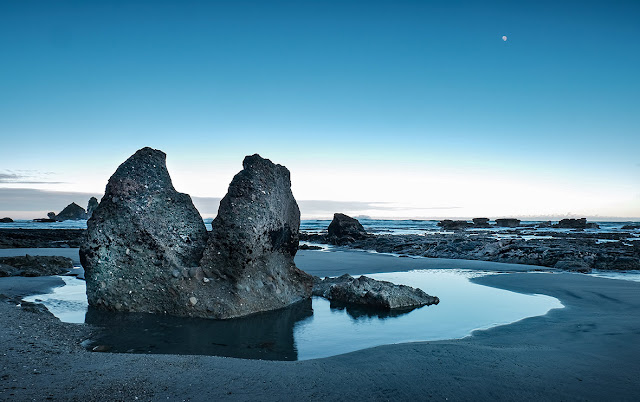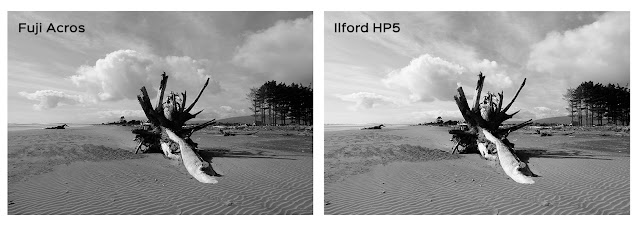Portra 400 film recipe for Fujifilm X-E2
I've been shooting Jpeg-only with my X-E2 for about a month now, and have finally tested out all my film simulation recipes. The last one to test, as indicated in the heading for this post, was my Kodak Portra 400 film recipe - in the C4 slot on my X-E2.
 |
| Motukiekie Moonscape. Fujfilm X-E2 with XC16-50mm. f/11 @ 1/3rd sec, ISO 100. Portra 400 recipe |
I've left testing the Portra 400 recipe until last because I think of it as fitting a fairly specific scenario. And I guess the clue is in the name - Portra. Do a quick Google search for Portra 400 on the interwebs and you will get hundreds of the kinds of images that this film was designed for.... Portraits.
As you can tell from my blog, I don't do a lot of portraiture. Not now anyways. I used to spend most weekends shooting Weddings, and I guess the Portra film simulation would have come in very handy in those settings. But now I'm mainly a landscape photographer (if I'm choosing what to shoot), so a 'Portra' style film seems a bit redundant?
 |
| Waterways. Fujifilm X-E2 with XC16-50mm. Polariser + Grad. f/11 @ 1/2sec, ISO 100. Portra recipe |
So why have I programmed it into one of my seven custom simulation slots on my X-E2? Well, I don't never not do portraits (did that make sense?), and so a portrait/skin oriented film recipe might actually come in handy one day. I've got seven to play with after all. I might shoot another wedding for a friend someday, in which case the Portra 400 simulation will likely get some use?
The other - perhaps more practical reason - for why I've programmed the Portra 400 recipe into my camera is because it uses a different white balance setting from the others. This is important in allowing me to set white balance shifts for the film simulations to get them closer to looking like the film they are supposed to be mimicking. I outline why this is important, and how it works in this blogpost.
 |
| Low Tide, Motukiekie Beach. Fujifilm X-E2. f/11 @ 1/6th, ISO 100. Kodak Portra 400 recipe |
And finally, just because it says Portra, doesn't mean you can't use it for landscapes - does it? Just look at the images for this post - all captured with the Portra 400 film simulation recipe. Just gorgeous!
The recipe uses a Daylight white balance setting (with +4 red and -5 blue), and this is obvious when shooting very early in the morning, before actual daylight. The colour balance is quite blue, despite the -5 blue channel reduction, since there's no 'daylight' available for the white balance setting to use to warm things up. Of course, because these are Jpegs, there's really no going back with white balance settings - it is what it is. So perhaps this isn't the best choice of recipe for very early, pre-dawn, lighting. Unless, of course, you actually like the blue cast that it is giving in the images. Which in some cases (although not all), I actually do.
 |
| Morning has Broken. Fujifilm X-E2 with XC16-50mm. f/11 @ 1/8th, ISO 100. Portra 400 recipe |
Now even though the film recipe says Portra "400" - which, with the actual film, would mean starting your ISO at 400 - I did cheat a little when using this recipe for these landscapes. I over-rode the ISO and set it manually to the 'Low' - 100 setting. I wanted to give myself the cleanest shadows when post-processing these jpegs, since I was having to under-expose quite a bit to retain information in the highlights of the sky. Even when using a neutral density graduate (Cokin Grey soft edge) filter.
I mentioned this in probably every post I've done so far on these film recipes, but it's worth repeating (again). If you're shooting Jpeg-only, highlights must be preserved at all cost. I'm bracketing my shots shooting Jpeg more than I did when shooting RAW - but in saying that, I'm actually very surprised at how under-exposed I can get and still manage to pull out detail and information from the shadows. In the photo above - Morning has Broken - the hills and foreground were practically black so that I would retain information in the clouds and sun-lit rocks in the distance. And yet, shooting at ISO 100, I've pulled out a serious amount of fairly clean detail from those shadows to create a pleasingly exposed image. I remain impressed with this 16MP X-Trans II Fujifilm sensor. It really is quite phenomenal.
 |
| Incoming tide, Motukiekie. Fujifilm X-E2 with XC16-50mm. f/11 @ 1/7th, ISO 100. Portra 400 |
When the sun does come out, and the Daylight white balance of the Portra simulation kicks-in, then the colours are very pleasing, if somewhat slightly muted. Probably exactly what you would want in a 'portrait' styled film. So what does the Kodak Portra 400 film recipe look like in the X-E2?
The -1 Highlight and Shadow tone flattens the curve and lowers the contrast somewhat, while the +2 colour punches some more saturation back into the classic chrome film base. As already mentioned, the 'daylight' white balance setting does mean that it's more suited for - well, daylight use. But if you don't mind your early morning/late evening landscapes taking on a blue hue, then Portra is certainly still worth using during low light.
 |
| Explosion. Fujifilm X-E2 with XC50-230mm. f/8 @1/2000th, ISO 1000. Kodak Portra 400 recipe |
Having said all that, and while I'm very happy with the landscape images I captured with the Portra 400 recipe, it probably won't get a lot of use. As already mentioned, I'm not shooting a lot of portraits. But it's there if I do. For landscape work I'm probably more likely to switch to either my Velvia recipe, or the Kodak E100SW recipe. Or, of course, Black and White.
Having now tested all the film simulation recipes I've programmed into my X-E2, and having shot Jpeg-only for the last month, I have to say I'm very pleased with the work-flow, the quality of the images, and the results.
For my final test, I'm going to shoot the same subject with all seven recipes so I can compare them side-by-side. I may even find an unsuspecting victim (err, I mean subject), and do some portrait comparisons with all the recipes too - just to make it fair.
Are you using film simulation recipes with your Fujifilm camera? Are you using any of the ones I've posted about on my blog? If so, which ones? I'd love to see some results if you would like to share? Leave a comment below and let me know....



Thanks for posting this Portra 400 and the Fuji Acros simulation recipes for the X-E2. After some trial and error (and help from a friend on Twitter), I figured out how to actually create a preset. I plan to try both recipes out tonight at a casual gathering with my wife's friends.
ReplyDelete